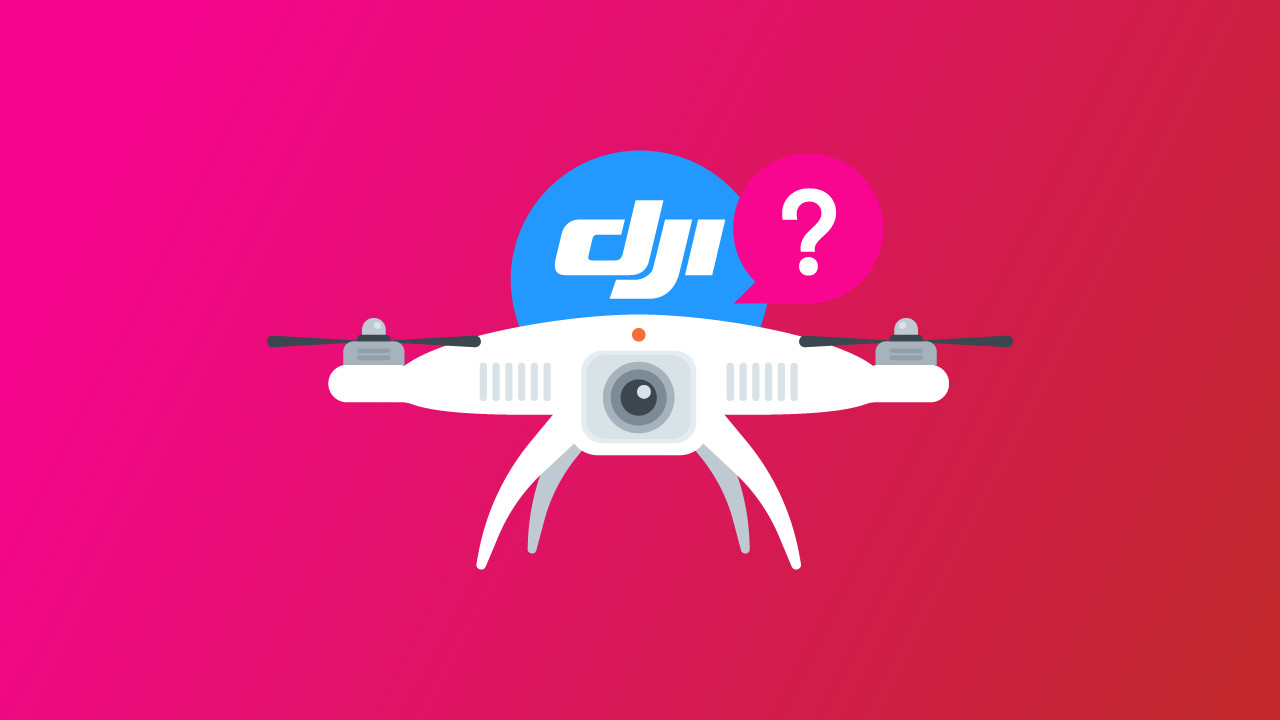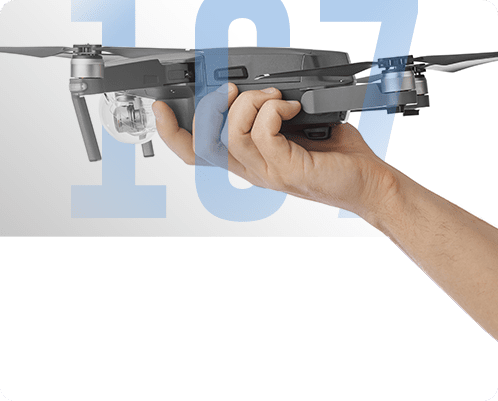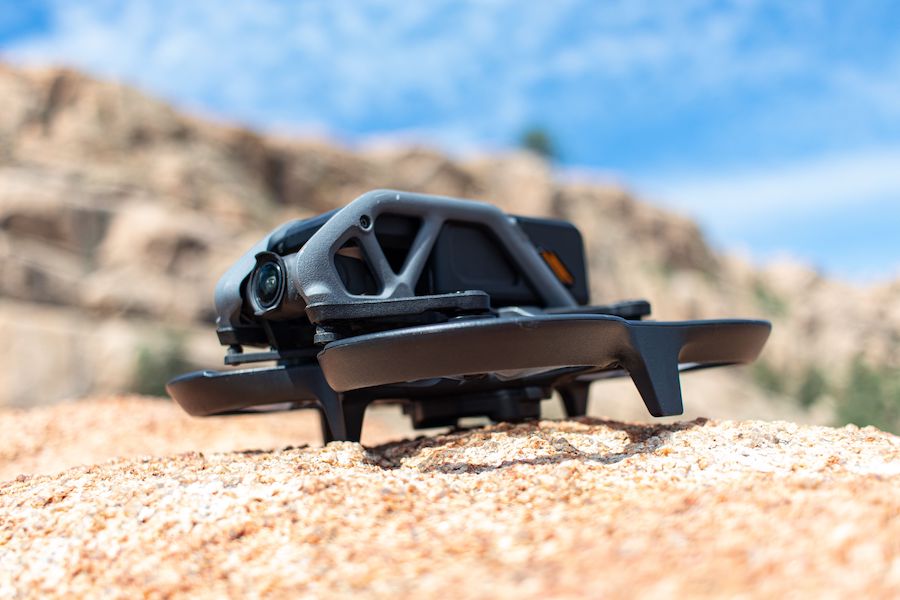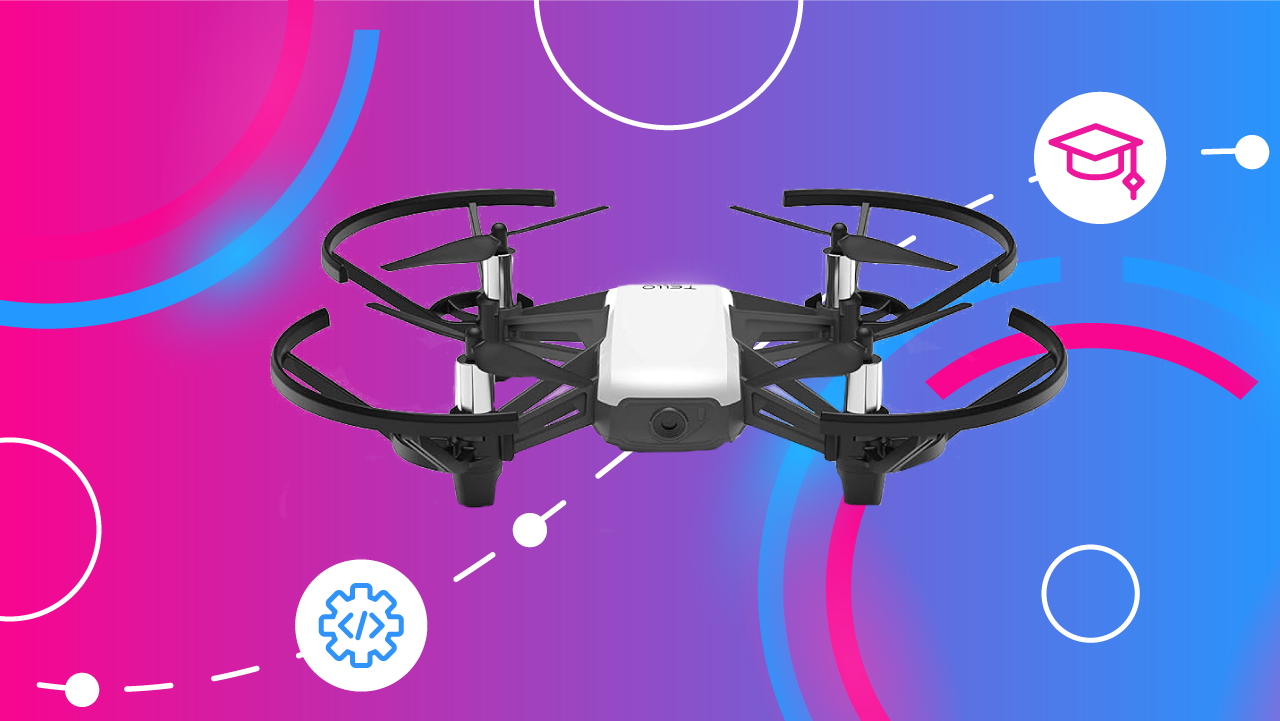-
Key Takeaways
-
Factors to Consider When Choosing a DJI Alternative
- Identify Your Needs
- Budget Considerations
- Key Features to Look For
- Brand Reputation and Support
-
Top DJI Alternatives by Budget
-
Budget-Friendly Options (Under $300)
- Potensic Atom SE / Atom
- Fimi X8 Mini
-
Mid-Range Options ($300 - $800)
- Autel Evo Nano and Nano+
- HoverAir X1 Pro and X1 Pro Max
-
High-End Options ($800 and Above)
- Autel Robotics Evo Lite+
- Anzu Robotics Raptor
-
Specialized Drones
- FPV (First-Person View) Drones
- Industrial and Commercial Use
-
Tips for Choosing the Right Drone
- Assess Your Skill Level
- Consider Future Needs
- Evaluate Customer Support and Community
- Check for Firmware Updates and Longevity
- Understand Legal and Regulatory Compliance
-
Conclusion
Want a high-quality drone but prefer to look beyond DJI? You’re not alone.
While DJI dominates the drone market—with around 80% global market share—numerous impressive alternatives cater to various budgets and specific needs.
Many users seek drones that offer different features, privacy assurances, or specialized capabilities.
This guide explores the top DJI alternatives, helping you find the best drone for your budget and requirements.
Heads up: Some links in this article are affiliate links. As an Amazon Associate we earn from qualifying purchases. This helps support the site so we can keep creating content for readers like you.
Key Takeaways
- Specialized Features – Some alternatives excel in FPV, industrial use, or modular designs.
- Budget-Friendly Options Exist – Quality drones are available at every price point.
- Know Before You Buy – Consider camera quality, flight time, and legal regulations.
Factors to Consider When Choosing a DJI Alternative
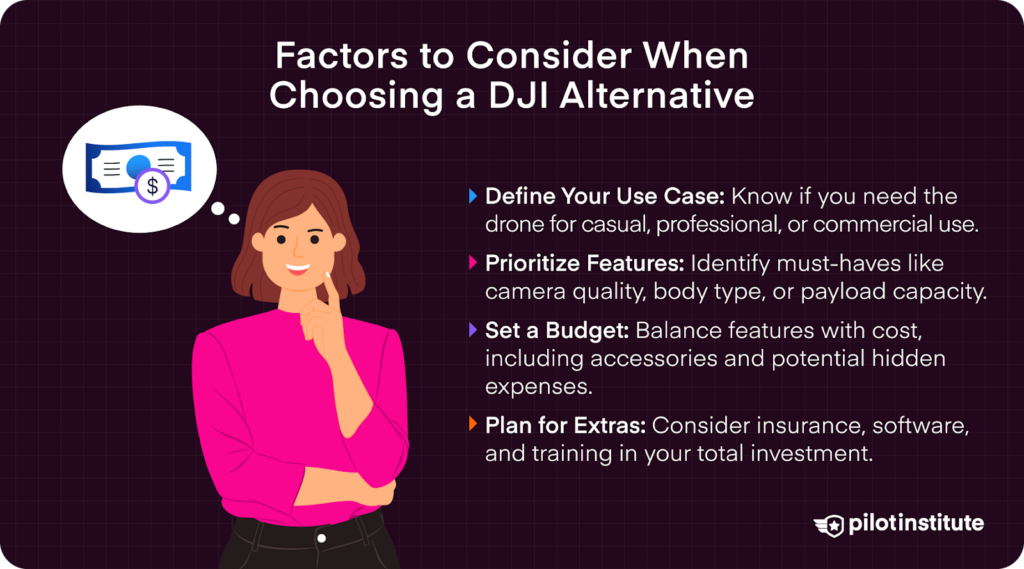
Identify Your Needs
The first step when choosing a DJI alternative is figuring out exactly how you plan to use your drone. Ask yourself:
- Will you be using it more for casual photography?
- Or is more professional videography a top fact?
- Do you need to use your drone commercially or in industrial applications?
- What features do you need most?
- Are there must-have features in terms of the camera, drone body, or payload capacities?
Understanding your specific use case helps tailor options well-suited to your needs.
Budget Considerations
Next, think honestly about your budget range. How much are you willing to invest in your drone and any accessories, such as extra batteries or propellers?
The best way to find value is to balance costs with features, ensuring you get the most essential capabilities without overspending on unnecessary extras.
And don’t forget—there are always potential hidden costs you should keep in mind as well. Insurance, software subscriptions, or training can all increase your final total.
Key Features to Look For
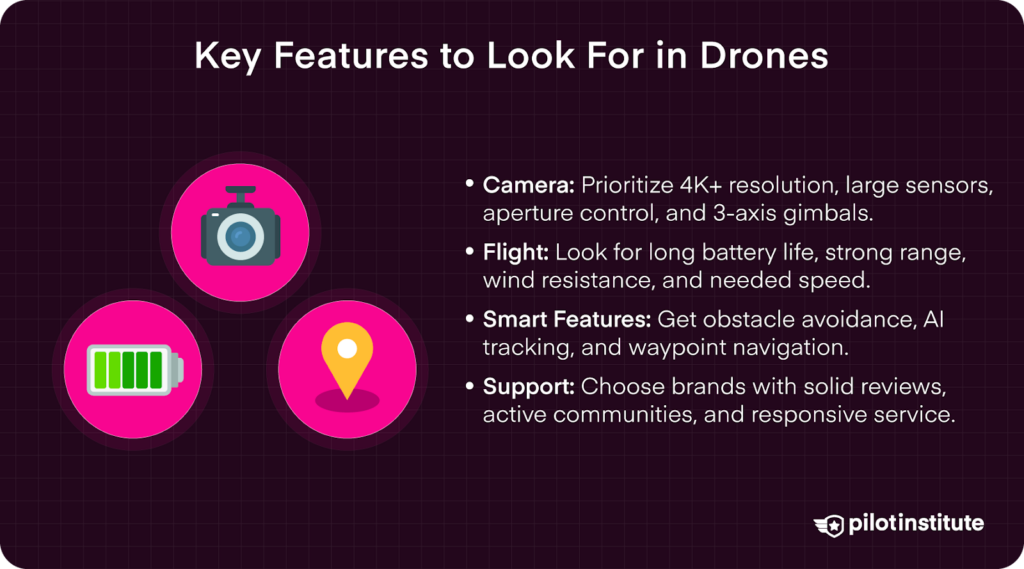
Camera Quality
Image resolution is typically the top feature to look at in terms of camera options. 4K is pretty standard for most modern drones, but make sure to check the frame rate. Shooting 4K is great at 24 or 30 fps, but if you can snag an option with 4K at 60 fps, that may be worth a few extra bucks.
A lot of options on the market today have even more impressive resolution capabilities. Many of the drones on this list can shoot in 6K or even 8K. If working in commercial videography, higher resolutions may justify a higher price point.
Yet, resolution is not the end-all when it comes to cameras. Sensor size is also key, as larger sensors offer superior image quality, especially in low-light conditions.
Speaking of low light, the aperture of a camera is also critical to provide users with better control over exposure. Having the ability to adjust the aperture improves image quality in a wider range of environments.
Gimbal stabilization is another element to pay attention to. For example, 3-axis gimbals provide much smoother footage.
Flight Performance
Battery life is a top component here, as longer flight times enable more extended flight activities. Drones offering top-flight times will have much more powerful batteries, which may increase the price.
Similarly, it is important to note the range capabilities of your top drone choices. Options with extended ranges offer more flexibility and fewer concerns about losing signal at inopportune moments.
Maximum speed is another factor to consider. Drones with higher max speeds are best equipped to capture fast-moving subjects. Other activities, like mapping or surveying, however, may not need blazing-fast speeds.
Drones with higher levels of wind resistance help diversify the environments you can fly in. Choose an option with high wind resistance and reliable wind testing.
Intelligent Flight Modes
One of the most important features to look for here is obstacle avoidance. Many top drone options offer multi-directional sensors for safer flying. Wide-angle sensors also improve the drone’s ability to recognize and avoid obstacles.
Cinematographers love tracking capabilities. Today, drones offer impressive AI-assisted tracking modes that allow autonomous tracking of video subjects.
Waypoint navigation modes are essential for surveying or mapping operations, offering pilots impressive pre-flight planning and smooth autonomous flying.
Circling back to AI, drones today offer a host of innovative AI features. Look for intelligent flight modes that can automatically recognize subjects or offer gesture controls for easy self-recording.
Brand Reputation and Support
Expanding your horizons can also open up the potential for pleasant surprises when thinking about brand reputation, customer service, and support.
Having reliable, dedicated customer support teams can help you avoid headaches and solve problems quickly—something that DJI simply cannot offer from overseas.
When exploring DJI alternatives, make sure to check customer reviews and community feedback. Looking at third-party resellers can offer a great source for specific product reviews.
Community forums are also a vast resource for learning more about a product’s pros and cons. An active user community is a valuable resource, as you can learn easily vicariously through others’ experiences.
Top DJI Alternatives by Budget
There are impressive DJI alternatives to suit any budget. Take a look at our best options for options under $300, mid-range, and high-end price points, along with notations for specialized interests and operations.
Budget-Friendly Options (Under $300)
Potensic Atom SE / Atom
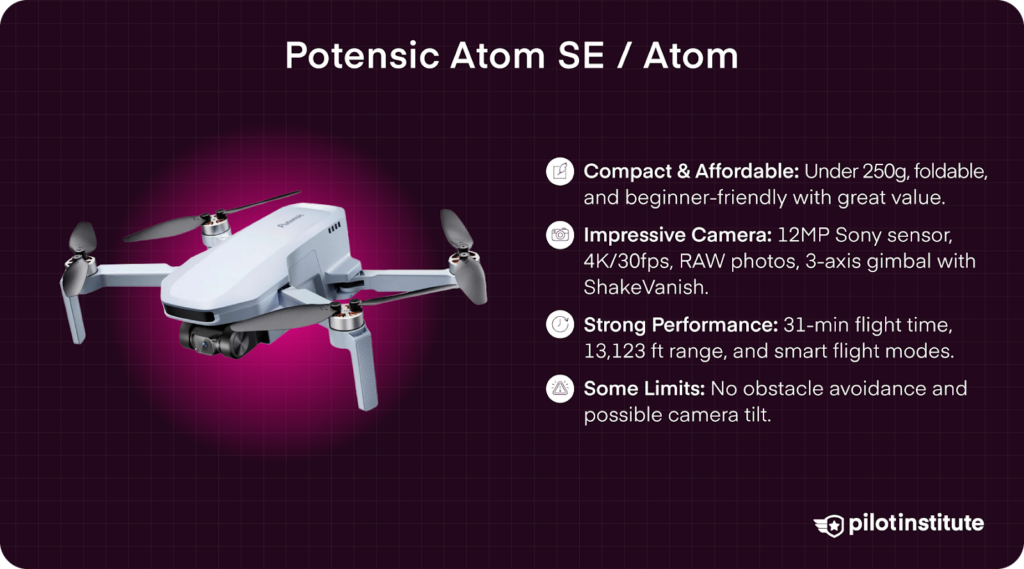
Affiliate disclosure: As an Amazon Associate I earn from qualifying purchases.
The Potensic Atom SE(paid link) packs a punch, despite its small size and price tag. Don’t let this small price tag fool you; the Atom SE has a ton of impressive features, making it a great option for beginners and hobbyists seeking affordable quality without sacrificing innovation.
- At under 250 grams, the drone body is foldable and incredibly portable.
- The Atom SE features a 12MP Sony CMOS sensor that is capable of capturing 4K video at 30 fps. The camera even offers manual controls and raw photo capabilities, which is truly rare at this low-end price point.
- This is mounted on a 3-axis mechanical gimbal, offering incredible stabilization. ShakeVanish technology reduces camera shake and ensures smoother shots, even for beginners.
- The Atom SE offers users up to 31 minutes of flight time, with a transmission range of 13,123 feet, or nearly 4 meters. There are also automated flight options, including a follow mode, circle fly, and waypoint operations.
- In March of 2025, Potensic’s store had the Atom SE listed at only $229.99 for the drone, controller, and single battery. Some kits come with controllers, extra batteries, and a carrying case priced at $279.99, with the potential for a $30 coupon to drop that price even lower.
- Still, it is important to note that the Atom SE lacks obstacle-avoidance capabilities. While suitable for flying in open areas, this means pilots have to be extra careful in more congested environments.
- Some users have also complained about the potential for the camera to tilt the horizon in shots unexpectedly.
Fimi X8 Mini
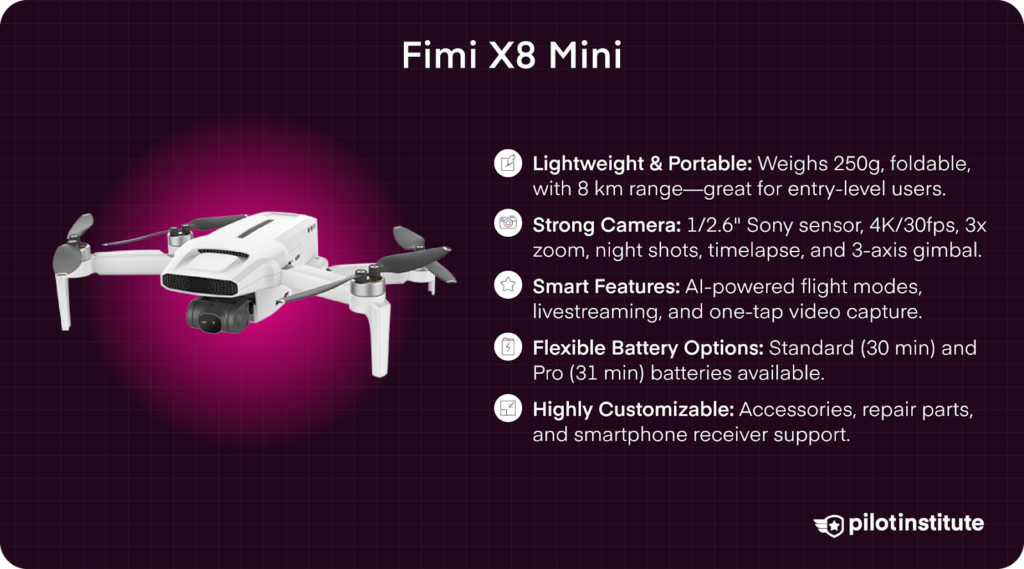
Affiliate disclosure: As an Amazon Associate I earn from qualifying purchases.
The Fimi X8 Mini(paid link) is another lightweight option with impressive 4K capabilities and solid flight performance. Overall, the Fimi X8 Mini is a good entry-level option with a surprising price point.
- Weighing only 250 grams, it is also foldable to fit right in the palm of your hand. Yet, it has a range of 8 km.
- It features a ½.6’ Sony CMOS sensor that is capable of 4K video up to 30 fps. The 3 times digital zoom combined with the 8km range makes the FIMI X8 Mini a great option for search and rescue operations.
- The camera is stabilized by a 3-axis mechanical gimbal, ensuring smooth shooting.
- Camera functions include a timelapse mode and advanced night shot performance for impressive images after dark. The Fimi X8 mini even offers livestreaming capabilities.
- Intelligent flight modes like follow-me, orbit, and waypoint modes are powered by AI. One tap video makes shooting fast, dynamic shots easier than ever.
- Users are offered a choice between standard and extended battery options, balancing weight and flight time. The standard 2400mAh lithium-ion battery is slightly heavier, weighing about 102 grams and claiming around 30 minutes of flight time.
- The Pro 2200mAh lithium phosphate battery is lighter, at only 86 grams. It offers an additional minute of flight time, for a total of around 31 minutes in the air.
- There are also tons of really cool Fimi X8 accessories that enhance its versatility. The website offers an upgraded receiver that is compatible with smartphones, much like DJI models.
- FIMI also offers accessories like drone body covers and even integral parts such as ESC and GPS boards, ensuring that users can make their own repairs.
- It starts at only $110, making it one of the most affordable drone options available.
- Yet, this means that it often sells out. As of March 2025, the FIMI X8 Mini was sold out on the brand’s website. Backorders should start shipping out in July 2025.
Mid-Range Options ($300 – $800)
Autel Evo Nano and Nano+
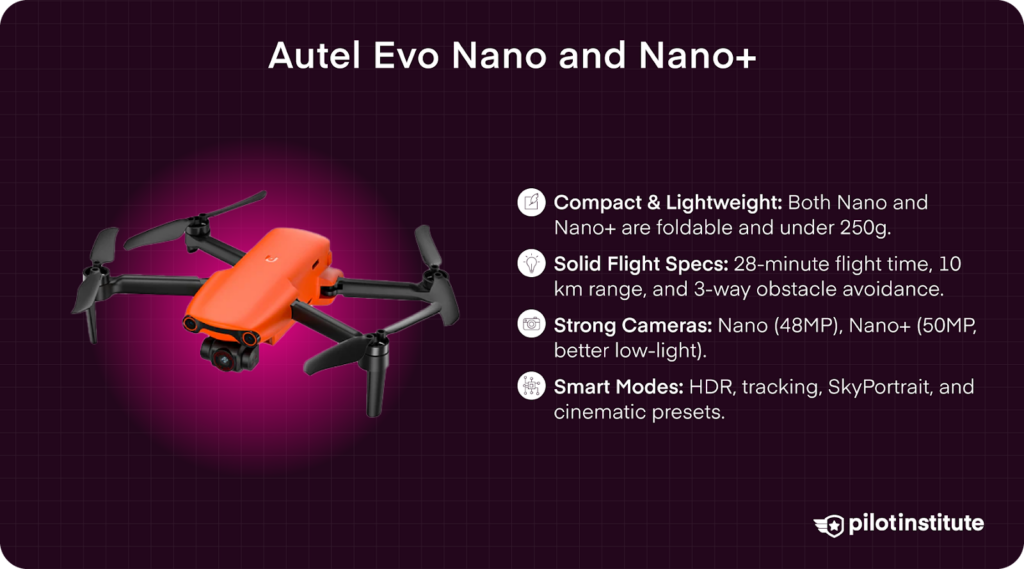
Autel’s Evo Nano series is an exciting mix of features in this mid-level price point category, making it ideal for enthusiasts wanting higher quality without a premium price tag. We recently listed the Nano+ as one of the best drones for beginners.
- The two options are both under 250 grams in a compact, foldable form factor.
- It features around 28 minutes of flight time with a 10 km range and the added safety of three-directional obstacle avoidance.
- The original Nano features a ½ inch 48 MP camera capable of 4K up to 30 fps. Yet, this model is hard to find right now, as it is not even sold on Autel’s website. You can still find it second-hand or at some third-party resellers.
- The newer Nano+ offers a larger 1/1.28-inch sensor for better low-light performance and more dynamic range. The 50 MP camera is capable of shooting 4K at 30 fps. Smooth stabilization is assured thanks to the 3-axis gimbal.
- The Nano+ boasts features like HDR video, advanced camera settings, and intelligent flight modes like dynamic tracking to keep your subject in frame, SkyPortrait for mid-air selfies, and modes similar to many DJI models, like Rocket, Rrbit, and Flick.
- As of March 2025, the Nano+ was listed at $679.
HoverAir X1 Pro and X1 Pro Max

Affiliate disclosure: As an Amazon Associate I earn from qualifying purchases.
The HoverAir X1 series(paid link) offers ultra-portable drones using super compact, foldable designs. Deployment is quick and easy, without the need for a controller!
- Both the Pro and Pro Max offer collision detection specialized for a wide variety of terrains, including even high-altitude snowy mountain peaks.
- Weighing only 192.5 grams, this is one of the most impressive options in the mid-level tier.
- The Pro shoots 4L up to 60fps, offering buttery smooth slow-motion footage. It also features a 104° FOV lens packed into its tiny form factor of only 191.5 grams.
- The ProMax takes everything up a notch. It features a 1/1.3” sensor with a 107° wide-angle, 16 mm lens. Impressively, it can shoot 4K video at 120 fps.
- The Pro Max can even shoot up to 8K. SmoothCapture 2.0 stabilizes footage on the two-axis gimbal.
- The Pro and Pro Max are both ideal drones for social media content creators needing high-quality footage on the go. Media storage allows for SD cards up to 1TB, unique for drones at this price point.
- The Dolly Zoom mode makes for dynamic, interesting shots with just a single click.
- AI-assisted tracking helps keep subjects in frame, even in tough, snowy environments.
- Indoor Follow mode makes it easy to shoot content inside, and there are even gesture controls for intuitive operation–great for solo content creators.
- The Pro starts at $499, with a $679 price point for the basic kit including an extra battery, charging hub, and case.
- The Pro Max is slightly higher, starting at $699, with a basic kit for $879.
- HoverAir also offers tailored kits offering accessories for cycling ($899) or skiing ($1,099).
- Still, the series is limited by shorter flight times. The Pro Max is only capable of 16 minutes due to its compact size. Subsequently, it is best for shorter use times with planned, quick shots.
High-End Options ($800 and Above)
Autel Robotics Evo Lite+
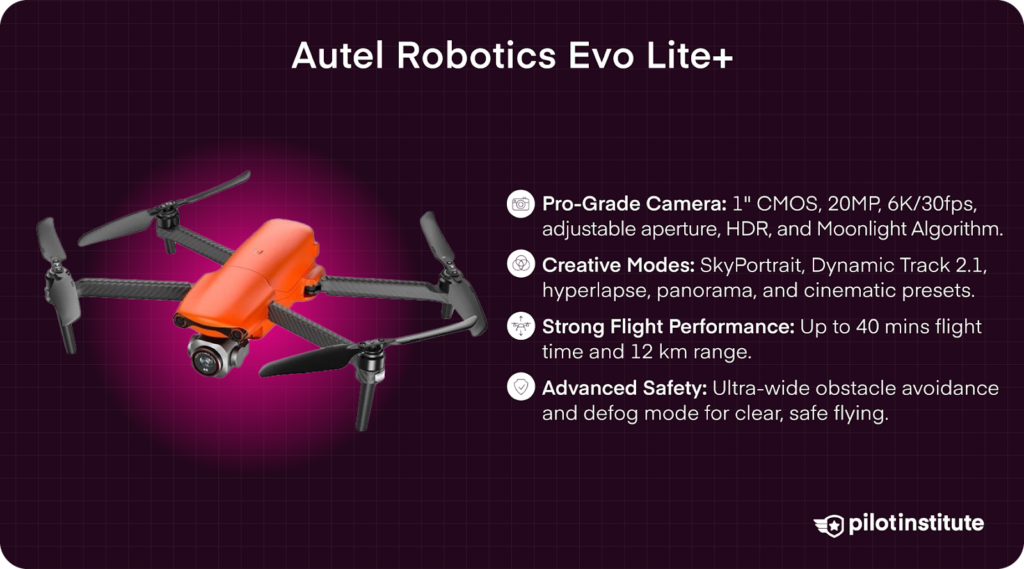
Autel Robotics’ Evo Lite+ is ideal for professionals needing extended flight durations and superior image quality, including enhanced low-light performance.
- Camera features are quite impressive on the Evo Lite+. It has a 1” CMOS 20MP camera capable of recording in 6k at 30 fps.
- There is even an adjustable aperture, ranging from f/2.8 to f/11. HDR capabilities also expand the dynamic range of images.
- This is what makes it such a versatile camera, able to capture impressive detail even in low-light environments. Autel’s Moonlight Algorithm enhances night footage, ensuring clarity and depth in dark conditions.
- The Evo Lite+ also has a defog mode that reduces haze and clarifies images in the field, saving work in post-production.
- Intelligent flight modes help capture dynamic shots with ease. SkyPortrait allows users to take selfies from above, while Dynamic Track 2.1 features superior tracking capabilities.
- Cinematic shots like rocket, orbit, flick, panorama modes, and hyperlapse functions increase your creative potential.
- Autel also promises up to 40 minutes of flight time and a massive range of 7.4 miles, or 12 km.
- The advanced obstacle avoidance sensors use an ultra-wide angle to ensure greater coverage areas.
- Autel’s website lists the Evo Lite+ at $1,149 for the standard bundle. The premium bundle with additional accessories was only $1,199 as of March 2025, 14% off its normal price.
Anzu Robotics Raptor
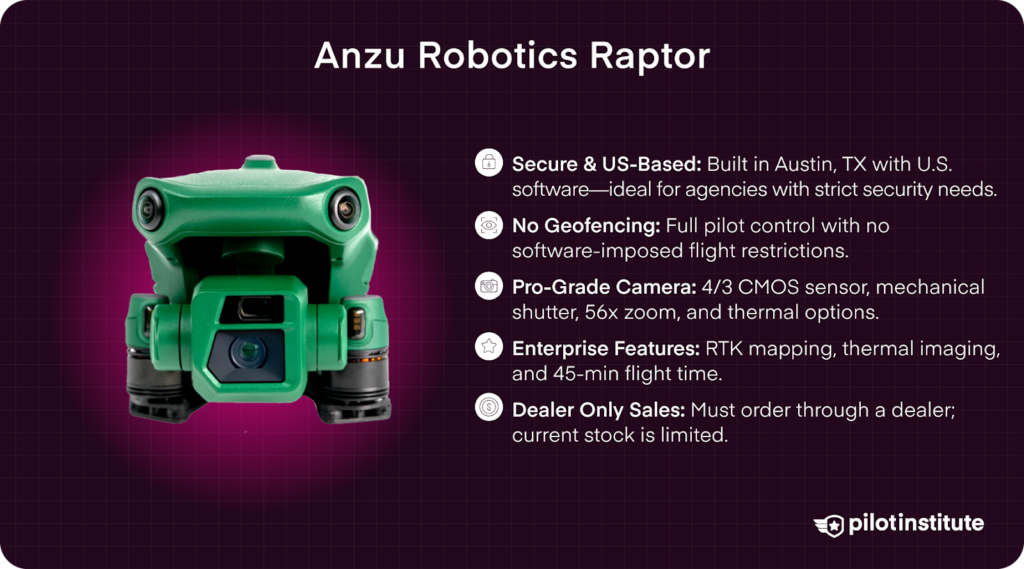
Next in this category is Anzu Robotics’ Raptor, a professional-grade drone resembling the DJI Mavic 3, but with the added security of using US-developed software.
- Based out of Austin, Texas, this drone is ideal for government agencies or businesses with strict security requirements.
- The company is not one to limit creative freedom. Anzu Robotics believes that “compliance with regulations and responsible drone usage lies with the user.” Thus, there are no geofencing limitations baked into the software.
- Raptor drones have a 4/3 CMOS high-quality camera with a mechanical shutter and 56x hybrid zoom. There is a low-light mode that ensures detail in darkness.
- Moreover, there are several specialized enterprise features. For one, the Raptor offers RTK mapping to enhance survey accuracy. The Raptor T Thermal is equipped with a 640 x 512 px thermal camera.
- The Raptor has comparable specs to the Mavic 3. Weighing about two pounds, the Raptor offers a notable 45 minutes of flight time.
- All of this, however, does come at a higher price point. The Raptor starts at $5,099 with one year of care protection included, while the Raptor T Thermal is at a much higher price point, $8,099 to be exact.
- Also, the purchasing experience is not a simple click-to-order situation. Sales are only through Anzu Robotics’ dealer network, which at the time of writing was largely out of stock. Currently, it is best to submit an inquiry and wait to be contacted by a team member.
Specialized Drones
FPV (First-Person View) Drones
BetaFPV Cetus X Kit
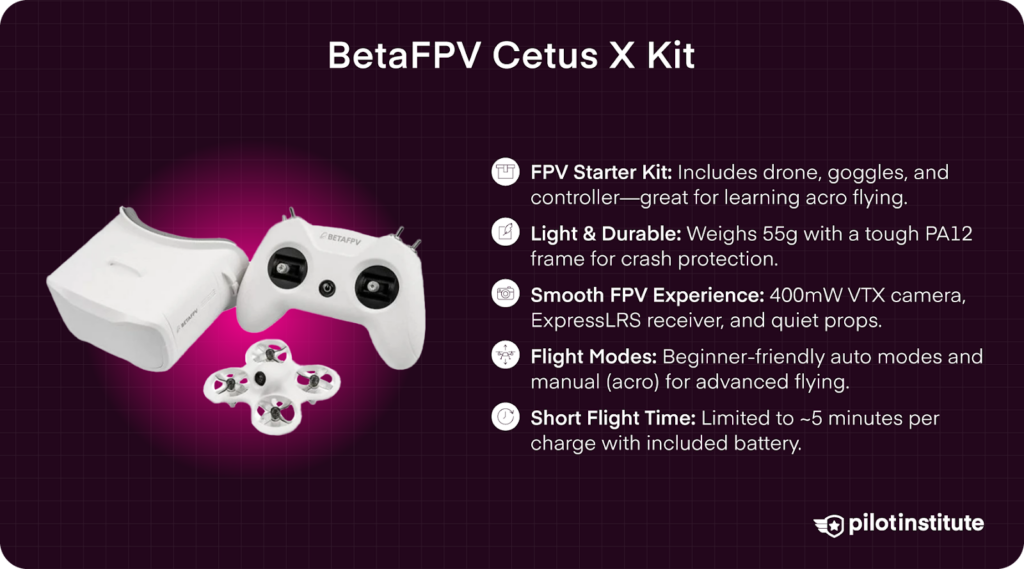
Affiliate disclosure: As an Amazon Associate I earn from qualifying purchases.
BetaFPV Cetus X Kit(paid link) is a build-it-yourself FPV powerhouse. Overall, the drone is ideal for beginners interested in learning FPV flying and acrobatics.
- It is a small, lightweight CineWhoop drone at only 55 grams.
- BetaFPV sells a complete FPV starter kit with goggles and a controller, offering immersive flight experiences.
- The drone offers some solid components. It uses an ExpressLRS 2.4G receiver that offers low latency and extended range. Smooth, quiet-blade props offer a pleasant flying experience.
- For capturing FPV adventures, the Cetus X features a 400mW VTX C04 FPV camera that covers 0° to 40°.
- Intelligent, progressive flight modes guide learners, while also offering more advanced users expanded creativity, such as in the manual (acro) mode.
- It boasts a sturdy but light frame built from PA12 material, offering 360° protection. This durable design is built to withstand crashes during the learning process.
- All of these features come with a surprising price tag of only $309.99 on BetaFPV’s website for the bundle that includes the Cetus X Brushless Quadcopter, transmitter, and VR03 FPV goggles.
- However, it only allows for 5 minutes of flight time with the VT2. 450mAh battery, its most limiting factor.
Industrial and Commercial Use
Parrot Anafi Ai
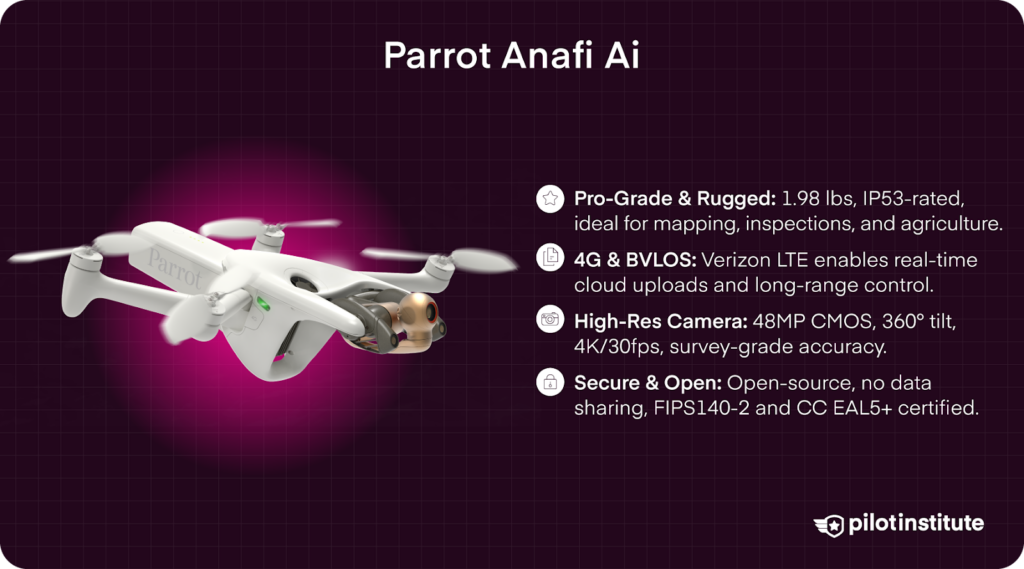
Parrot’s Anafi AI is one of the best enterprise drones with 4G connectivity and advanced features for professional applications. It is packed with some innovative features for work in the field.
- It is incredibly lightweight, at only 1.98 lbs.
- Yet, it is also robust and built to last. Its IP53 rating makes it dust and rain-resistant, suitable for various environments.
- The Anafi AI offers users 32 minutes of flight time with a max horizontal speed of 34 mph.
- Parrot subcontracted Verizon’s 4G LTE network, empowering the Anafi AI with WiFi, no matter where it is. Transferring flight data to the cloud does not have to wait until the end of operations.
- This increases its control, even over long distances. Impressively, it can conduct operations Beyond Visual Line of Sight (BVLOS) for more complex tasks outside of the range of competitors’ drones.
- The Anafi AI is a drone ideal for mapping, surveying, inspections, and agricultural uses. It is also compatible with Pix4D, the industry-leading professional photogrammetry and mapping software. Several photogrammetry flight modes are available to augment this process.
- Anafi AI’s unique biomimetic design allows for unobstructed 360° camera tilt.
- It also features a 48 MP ½” CMOS Sensor camera with a Quad Bayer color filter pattern that shoots 4K up to 30 fps. Parrot claims that this provides the Anafi AI with 55% more detail than competitors, including DJI models.
- The drone promises survey-grade accuracy with a GSD (Ground Sample Distance) of 0.46 cm/pixel and up to 30 meters in flight altitude. As such, it has clear mapping and modeling potential for any size operation.
- Parrot is also known for being trusted with data privacy concerns. The company uses open-source software integration for customized solutions and enhanced data security.
- The company states on its website that it does not share user data and performs cryptographic operations to enhance data security. This makes the Anai AI Compliant with FIPS140-2 and CC EAL5+ security certifications.
- At a price tag of $4,500, this option may be out of reach for some consumers and hobbyists.
Freefly Astro
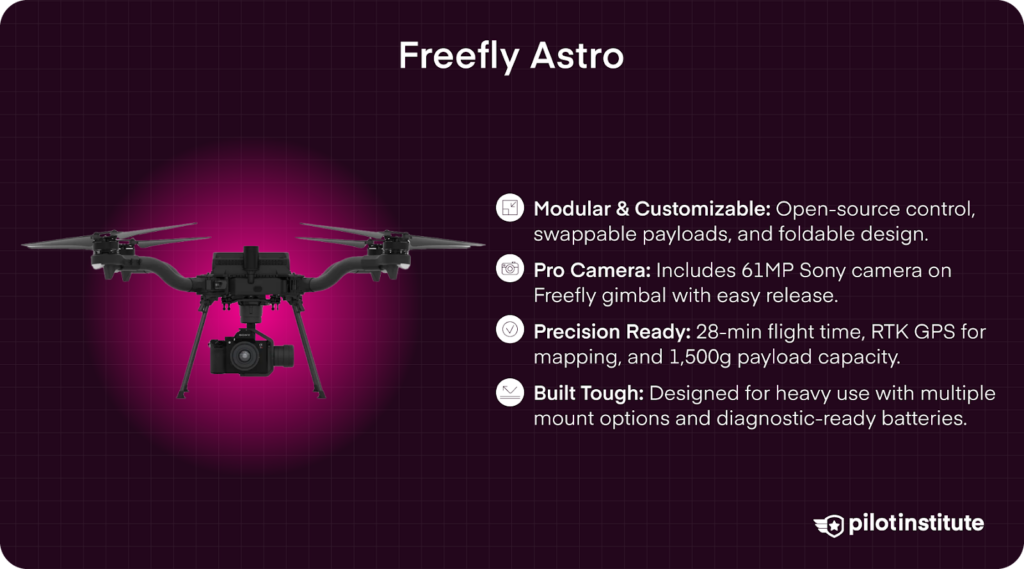
The Freefly Astro is unique in its modular design, open-source flight control, and built-in professional-grade Sony cameras. We recently listed it as one of the best drones made in the U.S. because of its feature-rich capabilities.
- Astro’s batteries offer power and reliability. Offering 28 minutes of flight time, the intelligent lithium-ion batteries have an OLED screen that makes it easy to check status and run diagnostics.
- Its unique, foldable design makes it easy to take on set.
- There are also diverse, customizable specs so that pilots can build exactly what they need.
- The Freefly gimbal comes with a pre-installed 61 MP Sony ILX-LR1 camera with a 24 mm lens.
- Yet, gimbals feature an easy-to-use payload release so you can switch cameras without a hassle.
- It also offers multi-band RTK GPS that provides centimeter-level precision for mapping tasks. This makes it ideal for cinematographers and industrial professionals needing high customization and payload flexibility.
- The Astro is also built for heavy use, boasting a robust and reliable build quality. It can carry payloads up to 1,500 grams.
- The drone is also compatible with a variety of payload mounts, including Vibration Isolated Gimbal Quick Release, Vibration Isolated Cheese Plate, and a Toad in the Hole.
- While it is feature-rich and customizable, it is also one of the priciest drone options on this list. Just the Astro Max starts at around $20,000.
- Add-on cameras, gimbals, and other tech can drastically increase the price. For example, the Astro Max Mapping Essentials kit is listed on Freefly’s website for $33,289.80.
Skydio 2+
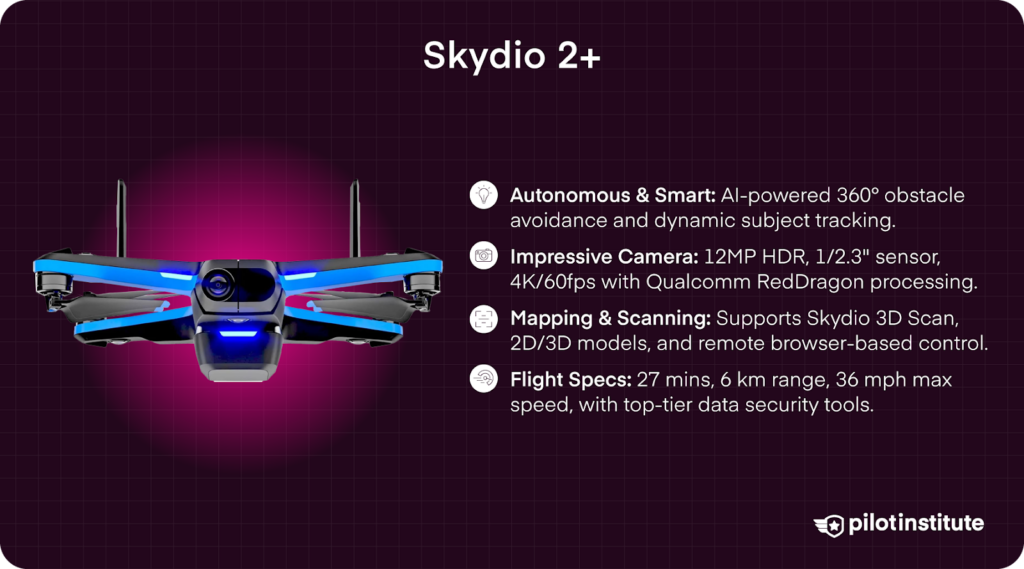
Finally, there is the Skydio 2+. While hard to get, it still warrants a position on this list of the best DJI alternatives. Advanced AI-driven functions really make this drone stand out.
- Skydio 2+ uses AI for unparalleled obstacle avoidance and autonomous flight. It uses 9 points of contact for a full 360° of obstacle avoidance.
- The drone is also known for its intuitive hands-free operation and industry-leading tracking systems that navigate complex environments. This is what makes it so ideal for action sports enthusiasts, filmmakers, and solo operators requiring dynamic tracking shots.
- Its camera is quite impressive as well, featuring a ½.3 CMOS sensor 12 MP HDR camera capable of 4K at 60 fps.
- The drone uses Qualcomm’s RedDragon processing power for super-fast speeds.
- There are six 200° wide-angle cameras, enabling fluid movement around obstacles.
- The Skydio 2+ offers users innovative integration into applications, such as Skydio 3D Scan–an AI-empowered scanning software. The drone offers impressive 2D and 3D field models, with cutting-edge automation tools to ensure precision mapping.
- It offers 27 minutes of flight time with a 6km range at a max speed of 36 mph.
- Fleet Manager offers unparalleled management for fleets of drones, while live streaming modes offer real-time data accuracy. Users can remotely fly the drone using a computer browser.
- Yet, it is important to note that there are limited manual controls, making this a good option for those prioritizing remote or autonomous flight operations.
- Security is a top priority here, as Skydio 2+ offers tools to efficiently and safely store and structure data.
- Starting at only $1,099, various bundles can help you maximize savings. There are kits for different activities, such as sports and cinematic applications.
- However, as of March 2025, Skydio limited the sale of the Skydio 2+ to enterprise consumers, leaving consumers out of the equation.
- Consumers can still purchase through third parties or used options.
Tips for Choosing the Right Drone
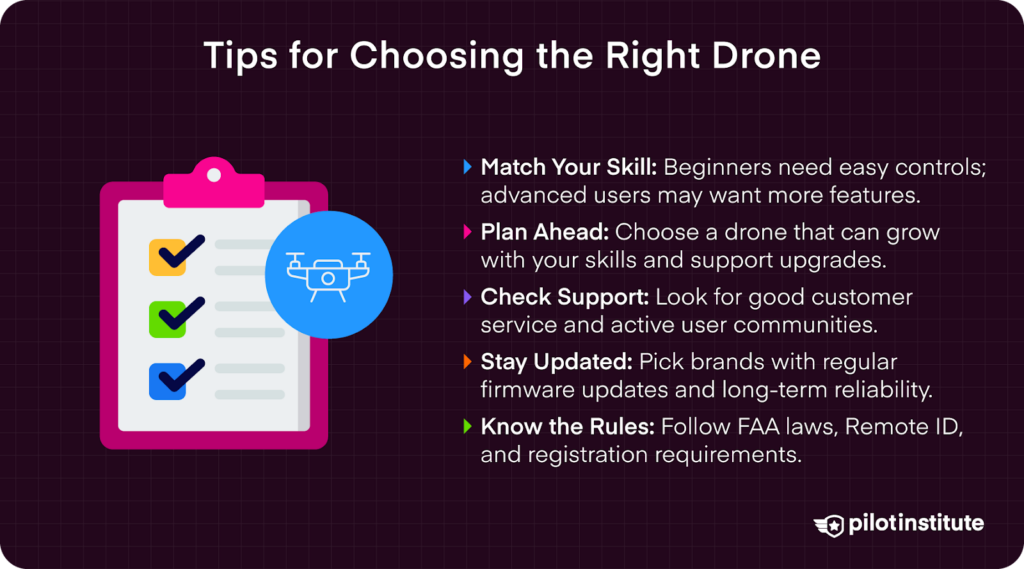
Assess Your Skill Level
It is important to know your strengths—and limits. Understanding your skill level empowers you to choose a drone that matches your piloting experience and comfort level.
Beginners may prefer models with easy-to-use controls, heightened safety features, and automated flight modes.
Meanwhile, advanced users may want more customization, specialized equipment, and cutting-edge technologies, although such features often come with a steep learning curve.
Consider Future Needs
When thinking about your typical use and skill level, don’t forget about how you will evolve as a pilot. To progress in your drone journey, it may be beneficial to seek out drones with more advanced features. Investing in a drone that can grow with your skills will ultimately help save money in the long run.
Speaking of the long-term, focusing on models that offer customer support, modular upgrades, or reliable firmware is also important to ensure a longer life for such a big purchase. This will help you future-proof your investment and ensure that you can customize your drone as needed.
Think about whether you’ll need advanced features as you progress in your drone journey.
Evaluate Customer Support and Community
While this was mentioned briefly earlier in the article, it is worth another look. Part of future-proofing your drone investment is purchasing from a company with responsive customer service for troubleshooting and repairs. This will help you better understand your new drone and receive critical assistance when needed.
Don’t be alone on your drone journey. Being active with a dedicated user community can help guide you to the right purchase and empower you throughout your ownership experience.
Engaging with other owners in forums and local in-person groups can enhance the experience and offer unparalleled access to resources, as other pilots can offer advice, shared experiences, and their favorite learning resources.
Check for Firmware Updates and Longevity
Choose a brand known for its reliable back-end support of its products. Look for manufacturers who regularly update their firmware for performance improvements and security patches.
Ongoing support extends the life of your drone and ensures it is compatible with constantly advancing technologies.
Keeping your drone’s firmware updated also offers potential new features and ways to improve the features you fell in love with in the first place.
Keeping up to date with firmware updates ensures a better flying experience with easier and more innovative features.
Understand Legal and Regulatory Compliance
As always, it is critical to be aware of regulations regarding drone usage, including registration and flight restrictions. The weight of your chosen drone could mean you are required to jump through more legal hoops to fly.
While drones under 250 grams do not require registration, they still demand safe and responsible flying.
Security is also something to be aware of when choosing a drone and operating it in certain applications. Models with Remote ID compliance built in ensure your investment is safe when the FAA rules finally kick in. Picking a drone with appropriate security clearance is also critical for landing clients in key industries.
Conclusion
DJI does make some innovative drone options—but it is not the only company with skin in the game. There are so many other innovative brands putting out impressive alternatives to the best DJI models at every price point.
Need more customization and specialized features? Options like Parrot’s Anafi AI and Freefly’s Astro have much more to offer than any comparable DJI model.
When looking for DJI alternatives, it is important to start with you first. Have a strong understanding of your use case scenario and skills overall as a pilot.
After evaluating your specific requirements, consider the factors outlined here to find the perfect drone for you.
Final Thought: The world of drones is vast and diverse—venturing beyond DJI can lead you to innovative technologies and the ideal flying companion for your unique needs.
